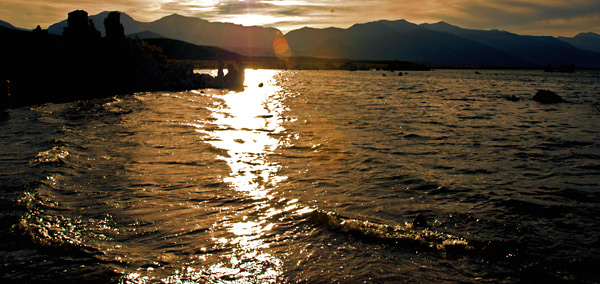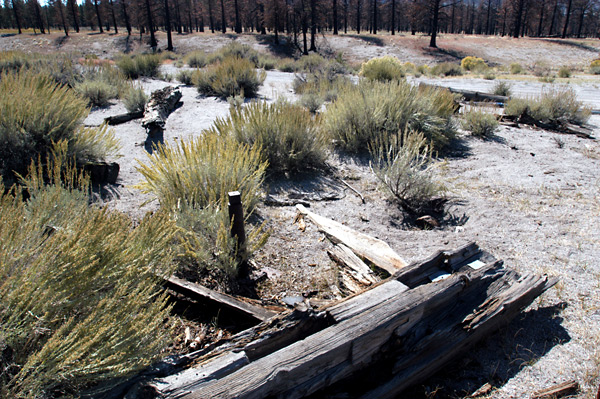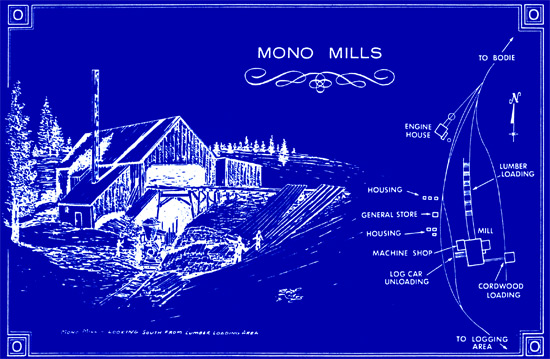|
Situated in a tranquil setting on the desert side of the
Sierra Nevada
,
Mono
Lake
has been
referred to as “the Dead Sea of America.” This large brackish
body of water contains a high percentage of sodium sulphate, two
small islands, no marine life, and very little vegetation on its
shoreline. The soil of the surrounding terrain is largely volcanic
sand and pumice which barely supports the growth of sagebrush, and
in places, is devoid of any growth.
The paradox to this picture is the forests of Jeffrey and
lodgepole pine a few miles south of Mono
Lake. It is
surprising that this country could bear trees, and incredible that
they would mature to four feet in diameter. However, the country
does, and the trees did, and therein lies the birth of a railroad.
 |
| Mono
Lake at sunset looking west to the Sierra Nevada Mountains. |
Huddled in the sagebrush-covered mountain, 30 miles north of Mono
Lake, was the
brawling, boisterous, gold mining town of Bodie, California. With a soaring
population of nearly 12,000, the town’s need for lumber to build
homes, timber for shoring mines, and wood for fuel was tremendous.
teamsters could not begin to meet the enormous appetite Bodie had
for consuming wood. The stage was set for the obvious answer to the
problem - build a railroad to the large timber stands south of Mono
Lake
.
 |
| Bodie,
California as seen from the cemetery. |
The Bodie Railway and Lumber Co. was organized on February
18, 1881, and shortly afterwards, J. T. Oliver surveyed the route
from Bodie to the mill site five miles south of Mono Lake.
When completed, the proposed 31.7 miles of roadbed was to
descend the 2,000 foot drop in elevation and traverse the alkali
flats on the eastern shore of Mono
Lake. Thomas Holt, an
engineer, was selected to ramrod the project. In addition to this
task, Holt was operating a five-ton steamship and several barges on
which materials and supplies were transported across Mono
Lake
to the railroad
construction crews.
While the sawmill was being built, grading for the roadbed
was started at the top of Bodie Bluff in May, 1881. With the aid of
two switchbacks, many cuts, and a 260-foot trestle, the steep and
circuitous grade down to lake elevation was accomplished, and by
mid-July, the first 20 miles of roadbed had been graded.
The first shipment of rails arrived in August, and as they
were being spiked into place, the final five miles of grading was
completed to the new mill. In all, some 2,00 tons of rails, spikes
and other supplies were used. The total cost of the road reached
$450,931. In addition, $81,390 was spent for equipment that included
4 engines, 12 service cars, 51 flat cars, and one caboose. The
“last spike” was driven on
November 14, 1881
, and a two-car
lumber train arrived afterwards to officially open the road.
The following weeks saw the new railway quite active with a
scheduled train leaving Bodie each day at
6:30 A.M.
and arriving at
Mono Mills at
10:00 A.M.
The train
departed the mill at
2 o’clock
each afternoon,
and arrived back at Bodie by
6:00 P.M.
The ten - to
twelve-car train was broken up into three sections prior to the
final approach to Bodie in order to negotiate the switchbacks and
3.8% grades. In addition to the problems caused by the sharp turns
and steep grades, the rolling stock was not equipped with air rakes.
Two brakemen were kept busy hopping from car to car setting the hand
brakes whenever the train began to gain momentum. There were many
derailments, but no fatalities among the crewmen were ever recorded.
The southern terminus at Mono Mills, while not a large
settlement, was a busy one. There were 200 men employed in the wood
and lumber business, and the aroma of fresh sawdust was everywhere.
Two large boarding houses and six smaller dwellings were located
near the mill. The single store supplied all the necessary goods
required by the residents, and was operated by Gilchrist, Sharp
& Company, who also had 40 mules packing wood, and two large ox
teams hauling lots to the mill.
 |
| Remains
of structures at Mono Mills today. |
The well equipped mill was one of the best in the state.
Located in a small ravine, the second floor was level with the
surrounding country so the heavy logs could be easily rolled into
the mill where 54 inch circular saws quickly reduced their size. One
44 inch “pony” and two smaller cut off saws completed the task
of transforming logs to lumber. The machinery was powered by a steam
engine, and water was obtained from springs and transported to the
mill by 2-inch pipe. The mill had the capacity for turning out
80,000 board feet every ten hours.
 |
| Drawing
of Mono Mills and Bodie RR trackage by Robert C. Likes. |
The greatest portion of Mono Mills output was in cordwood.
This relatively poor quality of wood was used as fuel to produce
steam power for the hoists and stamp mills at the Bodie mines. This
demand kept the flat cars loaded to capacity and helped offset the
low yield of only 8,000 board feet per acre for construction lumber.
The “last run” of the season was made on
January 7, 188, after which the
railroad closed down for the winter.
Read
More
|
